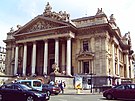| Financial markets |
|---|
|
Public market Exchange |
| Bond market |
| Fixed income |
| Stock market |
| Stock |
| Derivatives market |
| Securitization |
| OTC, non organized |
| Spot market |
| Foreign exchange |
| Exchange rate |
| Other markets |
| Money market |
| Practical trading |
| Participants |
| Finance series |
Unlike a stock market, the foreign exchange market is divided into levels of access. At the top is the inter-bank market, which is made up of the largest commercial banks and securities dealers. Within the inter-bank market, spreads, which are the difference between the bid and ask prices, are razor sharp and not known to players outside the inner circle. The difference between the bid and ask prices widens (for example from 0-1 pip to 1-2 pips for a currencies such as the EUR) as you go down the levels of access. This is due to volume. If a trader can guarantee large numbers of transactions for large amounts, they can demand a smaller difference between the bid and ask price, which is referred to as a better spread. The levels of access that make up the foreign exchange market are determined by the size of the "line" (the amount of money with which they are trading). The top-tier interbank market accounts for 53% of all transactions. From there, smaller banks, followed by large multi-national corporations (which need to hedge risk and pay employees in different countries), large hedge funds, and even some of the retail FX market makers. According to Galati and Melvin, “Pension funds, insurance companies, mutual funds, and other institutional investors have played an increasingly important role in financial markets in general, and in FX markets in particular, since the early 2000s.” (2004) In addition, he notes, “Hedge funds have grown markedly over the 2001–2004 period in terms of both number and overall size”.[9] Central banks also participate in the foreign exchange market to align currencies to their economic needs.
Banks
The interbank market caters for both the majority of commercial turnover and large amounts of speculative trading every day. Many large banks may trade billions of dollars, daily. Some of this trading is undertaken on behalf of customers, but much is conducted by proprietary desks, which are trading desks for the bank's own account. Until recently, foreign exchange brokers did large amounts of business, facilitating interbank trading and matching anonymous counterparts for large fees. Today, however, much of this business has moved on to more efficient electronic systems. The broker squawk box lets traders listen in on ongoing interbank trading and is heard in most trading rooms, but turnover is noticeably smaller than just a few years ago.
Commercial companies
An important part of this market comes from the financial activities of companies seeking foreign exchange to pay for goods or services. Commercial companies often trade fairly small amounts compared to those of banks or speculators, and their trades often have little short term impact on market rates. Nevertheless, trade flows are an important factor in the long-term direction of a currency's exchange rate. Some multinational companies can have an unpredictable impact when very large positions are covered due to exposures that are not widely known by other market participants.
Central banks
National central banks play an important role in the foreign exchange markets. They try to control the money supply, inflation, and/or interest rates and often have official or unofficial target rates for their currencies. They can use their often substantial foreign exchange reserves to stabilize the market. Nevertheless, the effectiveness of central bank "stabilizing speculation" is doubtful because central banks do not go bankrupt if they make large losses, like other traders would, and there is no convincing evidence that they do make a profit trading.
